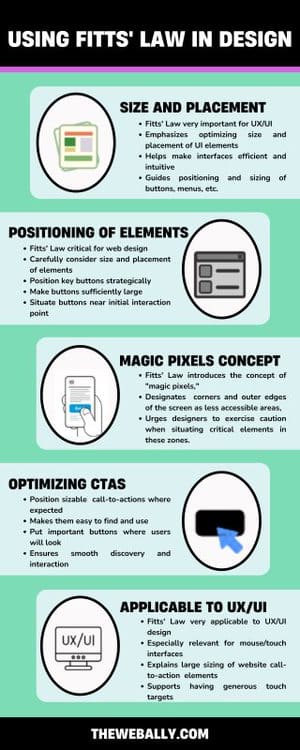All web designers need to constantly work on acquiring better skills for design. When designing, you begin to see everything in a new light.
Why is the scissor intended in the way that it is?
Why is one handle loop longer than the other? Every design is supposed to provide convenience for users, and your insight into every detail helps improve your skill constantly.
This is where Fitts’ Law comes in.
What is Fitts’ Law, and how can you boost your design skills? We will discuss this in detail so that you can improve your work style and become better at achieving convenient and valuable designs.
Fitts’ Law, proposed by psychologist Paul Fitts in 1954, explains that the time required for a person to move a pointer (e.g., mouse cursor) to a target area is influenced by the target’s distance and the target’s size. In simpler terms, the farther and smaller the target, the longer it takes to reach it.
This law is widely used in user experience (UX) and user interface (UI) design, especially when designing interactive elements like buttons.
For example, more prominent buttons are more accessible to click, which is crucial for finger-operated devices like mobile phones. Fitts’ Law emphasizes the importance of minimizing the distance between a user’s attention area and the related interactive element.
In practical terms, applying Fitts’ Law to web design means considering the size and placement of interactive elements.
For instance, essential buttons should be more prominent and closer to the user’s starting point. The law also suggests that corners and outer edges of the screen, known as “magic pixels,” are less accessible, so designers should avoid placing crucial elements there.
To summarize, Fitts’ Law helps predict user behavior on a website, guiding designers to create more user-friendly interfaces. It is often used in conjunction with other design principles for optimal results.

The significance of Fitts’ Law in the design landscape, particularly in the context of UX/UI, is profound. It underscores the imperative of considering the dimensions of interactive elements, with a keen focus on optimizing user interaction.
For instance, the law advocates for the enlargement of buttons, which is especially pertinent for devices operated by fingers, such as mobile phones. This emphasis on larger, more accessible buttons aligns with the broader goal of enhancing user efficiency.
Applying Fitts’ Law to web design entails meticulous attention to the size and placement of interactive elements. The Law’s tenets advocate for the strategic positioning of essential buttons, ensuring they are sufficiently large and situated near the user’s initial point of interaction.
The Law also introduces the concept of “magic pixels,” designating corners and outer edges of the screen as less accessible areas, urging designers to exercise caution when situating critical elements in these zones.
In everyday life, this principle appears straightforward.
The door button on a microwave is typically the most prominent because opening the door constitutes a critical action. In the realm of human-computer interaction, the concept is equally straightforward.
When your cursor is distant from a petite call-to-action (CTA), precision becomes essential for an accurate click, resulting in increased time and energy expenditure as you maneuver your mouse toward the CTA.
Conversely, precision becomes less crucial for a precise click when your cursor is close to a substantial CTA. This reduces time and energy consumption in navigating towards the CTA while achieving the same outcome.
Fitts’ Law finds extensive application in UX and UI design, particularly in interfaces involving pointing with a mouse or finger. It explains the rationale behind the generous sizing of call-to-action elements on websites.
Consider this: if you desire users to perform specific actions on your site, positioning sizable call-to-actions where users anticipate finding them ensures ease of discovery and interaction.
However, it’s essential to approach these guidelines with a degree of skepticism. While logic plays a role, it alone cannot orchestrate an exceptional user experience.
Human emotions propel behavior and draw us toward visually appealing and user-friendly objects.
Crafting a user-centric experience demands a profound understanding of human psychology.
Users can effortlessly make selections when an entire button or image is sizably conspicuous, clickable, and restricted by clear boundaries. The intuitive understanding of where to click and where not to bond is facilitated.
Conversely, requiring users to precisely aim their cursor at a specific part of a button, such as the text, demands greater precision, resulting in more time and effort.
Nevertheless, the adage “bigger isn’t always better” holds. Excessive enlargement of a button may yield diminishing returns in usability.
A button that surpasses a certain size threshold risks disrupting the visual equilibrium of a page and occupying valuable real estate that could be better allocated to white space or another call-to-action.
Optimal usability occurs when buttons are sufficiently large to command attention without compromising the visual balance of the page.
If you need help with your website design, our team at The Web Ally can help. Contact us now for more details.
Self-service covers every aspect of life these days, but we still believe in the power of having someone to talk to. Maybe it's to bounce off ideas and explore new opportunities. Maybe it's just to say hello.
In any case, we will only use your contact details to get in touch with you regarding your enquiry - and nothing else!